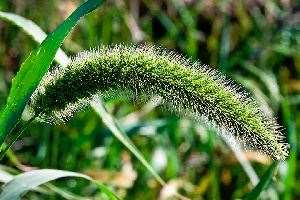Field Guide  Weed Management
Weed Management  Giant Foxtail
Giant Foxtail
Giant Foxtail (Setaria faberii)
Crop Impacts: Carrot, corn, pea, soybean and potato
 | |
About Giant Foxtail:Giant Foxtail is an annual grass the reproduces by their seeds only. It is native to China but has become a competitive grass throughout North America and has the power to greatly reduce the yield of many crops. The aspect that makes this grass so hard to control is its adaptability to all types of soil and has a high tolerance to drought. One of the major problems with Giant Foxtail is that is has the ability to produce a lot of seeds that can start to grow without lying dormant for a period of time. If it has enough light, it can quickly take over an area of crops if not properly controlled. Family: Grass Family (Gramineae)  
Giant Foxtail Scouting and Prevention:The stem of a Giant Foxtail can get up to 2 m tall with leaf blades that are 20 to 55 cm long and about 2 to 17 mm wide. These leaves are finely haired on the upper surface and occasionally on the underside of the leaf. The inflorescence dense, spike flowers can be erect or slightly curved and are about 4.5 to 17 cm long and 1.5 to3 cm wide, covered in yellow to green bristles which flower in late July to October. Common locations- - Carrot fields
- - Corn fields
- - Pea fields
- - Soybean fields
- - Potatoes fields
PreventionPrevention of Giant Foxtail is less expensive and less time-consuming then trying to control it. Make sure when you seed a new area that you do so with certified weed-free seeds. Giant Foxtail competes well with row crops such as soybeans and corn, meaning that a good crop rotation with solid stand crops like grasses or legumes can help contribute to control and/or prevention of this weed. If there is an infested area on your property, be sure to drive around instead of through it. Finally, make sure to give all equipment that has been in infested fields a good clean so that no seeds are transferred. Giant Foxtail Control:It is recommended to use a combination of both chemical and cultural control methods for taking control of Giant Foxtail in your row crop fields. Cultural ControlA cost effective way to prevent Giant Foxtail from spreading is to mow infested areas before the grass produces seeds. Here are a few steps that may help you to control this particular weed. - - Do the recommendations given to you by the soil test
- - The field should be planted with high-yield varieties in narrow rows with high plant population as soon as ideal soil and weather conditions are met
- - Provide nutrients necessary for early canopy closure and fast, hearty crop growth
Chemical ControlDue to the fact the Giant Foxtail germinates throughout the summer, full-season control is very difficult. If you apply herbicides very early in the season, most times it will lose its effectiveness when the Giant Foxtail reaches peak germination. As a result, Giant Foxtail causes more problems in fields that are planted early in the season. Depending on your location, Giant Foxtail could be resistant to sulphonylurea and imidazolinone (WSSA group 2) herbicides. Latin / Alternative Giant Foxtail names:- - Setaria faberii Herrm.
- - Sétaire géante
- - Sétaire de Faber
- - Nodding foxtail
- - Giant bristlegrass
- - Tall foxtail
Additional Giant Foxtail Resources |
http://www.cropscience.bayer.ca/Pest-Finder/Weeds.aspx#Keywords%2Fgiant%20foxtail%3B%7C
http://www.omafra.gov.on.ca/english/crops/facts/ontweeds/giant_foxtail.htm
http://www.cropscience.bayer.ca/en/Pest-Finder/Weeds/Grassy/Giant-foxtail.aspx#accordion_2
http://www.weedinfo.ca/en/weed-index/view/id/SETFA
http://extension.psu.edu/pests/weeds/weed-id/giant-foxtail